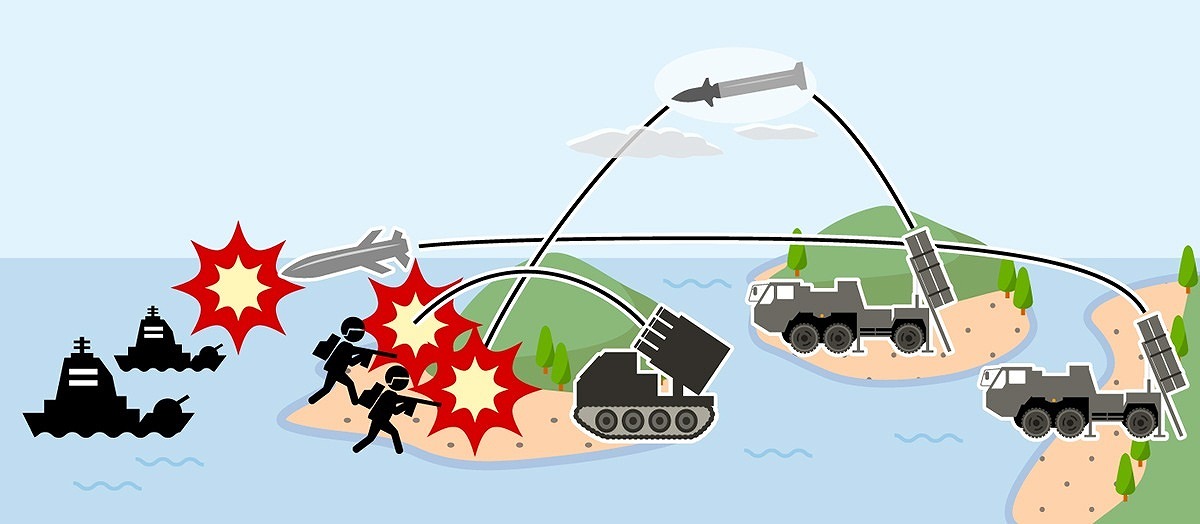Deployment of Longer-range Anti-ship Missiles Eyed for Kyushu; Nearer Range to Be Covered by Hypersonic Missiles, Rockets

6:00 JST, July 22, 2024
The Defense Ministry has begun coordinating for the deployment of improved surface-to-ship missiles and high-speed gliding missiles to the Ground Self-Defense Force’s Western Army in Kyushu as early as fiscal 2026. The improved anti-ship missiles will have a range of over 1,000 kilometers, several times farther than the current model can reach.
The planned deployment at the Western Army’s 2nd Artillery Brigade in Yufu, Oita Prefecture, is aimed at beefing up defense of the Nansei Islands by deploying several types of missiles with different ranges, given China’s continued aggression at sea in the region.
According to government officials, the improved surface-to-ship missiles are being developed based on the current Type 12 surface-to-ship guided missile, which has a range of several hundred kilometers.
When deployed in Kyushu and Okinawa, the new missile, in the event of an emergency, will be able to hit an enemy ship farther away than existing guided missiles can.
Standoff defense capabilities, which allow missiles to be launched from outside an enemy’s range of defensive fire, are considered a pillar of the National Defense Strategy formulated by the government in 2022. This has led to the timeline for improved missiles being pushed forward.
Those enemy units that manage to dodge these long-range missiles and land on the Nansei Islands would be hit with new missiles Hyper Velocity Gliding Projectiles (HVGP), which the ministry plans to deploy for the defense of the remote islands.
The gliding missiles will be equipped with a warhead that falls at high speeds, making it more difficult for an enemy to intercept. They will have a range of several hundred kilometers, and would likely be fired from an island close to the island under attack.
At the same time, multiple launch rocket systems (MLRS) that would be deployed beforehand would launch rockets simultaneously against an enemy force tens of kilometers away.
The ministry plans to defend the remote islands with a “three-tiered” defense network of missiles for long, medium and short range. The improved anti-ship missiles and new gliding missiles will be developed by the domestic defense industry.
The GSDF intends to use the new gliding missiles as a trump card for defending the remote islands. “Defense equipment that makes an enemy hesitate to approach Japanese territory will aid deterrence,” said one government official.
The 2nd Artillery Brigade is also being considered as a likely home for a unit specializing in gliding missiles, which will be established by fiscal 2032.
"Politics" POPULAR ARTICLE
-

Japan to Support Central Asian Logistics Route That Bypasses Russia, Plan to Be Part of Upcoming Summit in Tokyo
-

Japan to Tighten Screening of Foreigners’ Residential Status by Providing Information of Nonpayment of Taxes
-

Takaichi Cabinet Approval Holds at 72% as Voters Back Aggressive Fiscal Stimulus, Child Benefits
-

Chinese, Russian Bombers Flew Unusual Path by Heading Toward Tokyo; Move Likely Meant to Intimidate Japan
-

Takaichi Meets Many World Leaders at G20 Debut in Johannesburg; Speaks with Heads of Countries Including Italy, U.K., Germany, India
JN ACCESS RANKING
-

Keidanren Chairman Yoshinobu Tsutsui Visits Kashiwazaki-Kariwa Nuclear Power Plant; Inspects New Emergency Safety System
-

Imports of Rare Earths from China Facing Delays, May Be Caused by Deterioration of Japan-China Relations
-

University of Tokyo Professor Discusses Japanese Economic Security in Interview Ahead of Forum
-

Japan Pulls out of Vietnam Nuclear Project, Complicating Hanoi’s Power Plans
-

Govt Aims to Expand NISA Program Lineup, Abolish Age Restriction
























